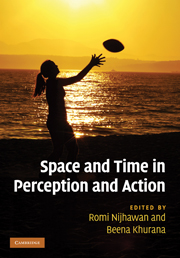Book contents
- Frontmatter
- Contents
- List of contributors
- Acknowledgments
- 1 Space and time: the fabric of thought and reality
- Part I Time–space during action: perisaccadic mislocalization and reaching
- Part II Temporal phenomena: perception
- Part III Temporal phenomena: binding and asynchrony
- 13 Dynamics of visual feature binding
- 14 How does the timing of neural signals map onto the timing of perception?
- 15 Mechanisms of simultaneity constancy
- 16 Relative timing and perceptual asynchrony
- 17 The time marker account of cross-channel temporal judgments
- 18 Simultaneity versus asynchrony of visual motion and luminance changes
- Part IV Spatial phenomena: forward shift effects
- Part V Space–time and awareness
- Index
- References
16 - Relative timing and perceptual asynchrony
from Part III - Temporal phenomena: binding and asynchrony
Published online by Cambridge University Press: 05 October 2010
- Frontmatter
- Contents
- List of contributors
- Acknowledgments
- 1 Space and time: the fabric of thought and reality
- Part I Time–space during action: perisaccadic mislocalization and reaching
- Part II Temporal phenomena: perception
- Part III Temporal phenomena: binding and asynchrony
- 13 Dynamics of visual feature binding
- 14 How does the timing of neural signals map onto the timing of perception?
- 15 Mechanisms of simultaneity constancy
- 16 Relative timing and perceptual asynchrony
- 17 The time marker account of cross-channel temporal judgments
- 18 Simultaneity versus asynchrony of visual motion and luminance changes
- Part IV Spatial phenomena: forward shift effects
- Part V Space–time and awareness
- Index
- References
Summary
Summary
How do human observers determine the relative timings of different events? One perspective, which I shall refer to as the brain–time theory of perception, suggests that apparent timing is related to when specific analyses are concluded within distinct and relatively independent regions of the brain. This proposal is controversial, not least because it suggests that temporal perception is error prone and subject to the rates at which analyses are concluded in different parts of the brain. One observation that may favor this perspective is that physically coincident changes in color and direction can appear asynchronous – a perceptual asynchrony. In this chapter I will review the theoretical interpretations and empirical evidence that relate to this phenomenon. I will argue that this timing illusion provides good evidence for a relationship between the time courses of sensory processing in the brain and perceived timing.
Introduction
How do we determine relative timing? Human observers can determine the relative timings of a remarkable variety of events. For instance, we can judge the timings of visual relative to other visual (Moutoussis & Zeki 1997a,b), auditory (Fujisaki et al. 2004), and haptic (Vogels 2004) events. Subjectively it seems that one of the events can be entirely intrinsic to the nervous system, like the sensation of reaching seven while mentally counting from one to ten. The fact that these judgments can be made dictates that the necessary information is encoded in a form that can then be reported – but it is not clear how this feat is achieved.
- Type
- Chapter
- Information
- Space and Time in Perception and Action , pp. 254 - 277Publisher: Cambridge University PressPrint publication year: 2010
References
- 3
- Cited by



